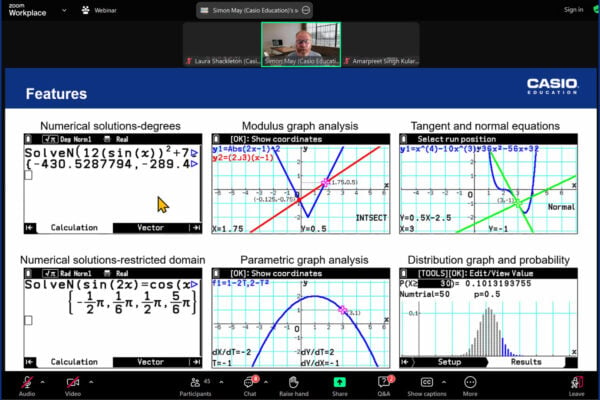Mastering A-level maths exams: strategies and resources

A-level maths exams are a serious challenge, so it makes sense to use every tool available to get yourself ready for examination day.
In this blog, we:
- Recap the format that A-level maths exams typically take
- Highlight some of the benefits of revising with past papers
- Discuss what you should bear in mind where calculators are concerned
- Point out some common calculator mistakes to avoid
- Provide a list of important things to check and remember before going into the exam hall
Understanding the A-level maths exam format
The chances are you’re already familiar with the A-level maths exam format, but here’s a quick refresher if you need to jog your memory.
These points are based on the Pearson Edexcel A-level maths exam papers from June 2023 (the most recent available). There may be some differences between exam boards.
- The exam is divided into three separate papers, two on pure maths and one on applied maths (statistics and mechanics)
- You usually have two hours to complete each paper
- Papers typically award a total of 100 marks each and are equally weighted in terms of their contribution to your overall grade
- Questions are presented in various formats, from short questions with single-mark answers, to more complex problems that require critical thinking
- Marks are available for both correct answers and for showing understanding through your methods and working
How past papers can help with maths exam preparation
You can access A-level maths past papers on the official websites of the AQA, Pearson Edexcel and OCR exam boards, or on websites such as Maths Genie.
Working through past papers can help you prepare for your own assessments by familiarising yourself with the types of questions that often appear in exams.
It also allows you to test and brush up on the mathematical theory you’ve been learning by applying it to questions of different lengths and formats.
AQA Paper 1 from June 2023, for example, gives you the opportunity to practice:
Revising with past papers can be an effective way to highlight areas you need to strengthen before your exam.
This approach can also help you practice under timed conditions and get used to allocating your time efficiently to different types of questions.
Best Casio calculators for A-level maths exams
Our recommendation is for A-level maths students to use a graphic calculator to the broader range of functionality available on these devices and how this can help you answer exam questions.
When you come across questions that involve solving equations, for example, you can use features available on Casio graphing handsets, such as SolveN, to back up your answers.
It’s important to do the algebraic work and show this on your exam paper to get full marks, but your calculator can provide reassurance that your final answer is correct.
In addition to SolveN, you can use your handset’s graphing functionality to view solutions in different ways. You might find it easier to solve simultaneous equations graphically by looking at where two lines intersect, for example.
Our graphic calculators also feature tools such as Distribution mode, which allows you to not only calculate probability distributions, but display them graphically.
This can prove particularly useful when you want to clarify and understand the scenarios you’re given in exams by visualising them.
Avoiding common calculator mistakes in A-level maths exams
Don’t expect the calculator to do the work for you
A calculator can prove highly beneficial when you need to check your work and perform complex calculations, but relying on it too much could cost you marks.
Lots of questions expect you to present the method you’ve used to reach your answer, so simply writing out a solution you’ve got from your calculator is unlikely to be enough.
Be wary of input errors
Over-reliance on your calculator could also cause problems if you make a mistake and you’re not using other methods to back up your work.
A small input error in a complex calculation, for example, could send you down the wrong path and give you an incorrect answer. This might go unnoticed if you aren’t combining your calculator operations with written work.
Check your angle setting
Another common mistake to be aware of is working in degrees when you should be in radians, or vice versa. This could produce some wildly inaccurate results, so it’s important to know how to switch between degrees and radians.
Stay alert to rounding errors
Rounding errors can creep in if you’re not paying enough attention to the number of decimal places or significant figures requested in the exam question.
It’s important to expand any values that may have been truncated in your calculator display, and also to use your own knowledge to ensure you’re rounding correctly and providing what the question has asked for.
The key point to remember is that calculators are an incredibly powerful tool, but like any tool, they need to be used in the right way.
Exam day checklist
Make sure you can tick off the points on this list to feel fully prepared as you go into the exam hall:
- Do you have plenty of spare black pens for filling in the question paper and pencils for sketching graphs and diagrams?
- If you’re using a graphic calculator, do you know how to put it into exam mode?
- Does your calculator have a fresh set of batteries?
- Have you reset your calculator to clear previously saved variables and calculations?
- Have you checked your calculator’s display settings to ensure you can use it comfortably in the exam hall?
For more help and support with preparing for your exams, check out the Casio Education blog or sign up for one of our student revision webinars.
You can also find lots of useful resources on YouTube. For example, this video on maths teacher Seb Bicen’s channel, Bicen Maths, discusses the one mark Seb dropped when he sat the A-level maths exams in 2024.
We’ve had the opportunity to collaborate with Seb at Casio Education and he has a huge library of useful content available on his YouTube channel, which is definitely worth checking out ahead of your exams.



